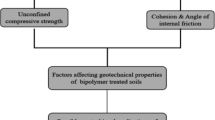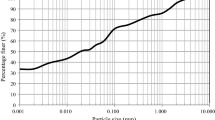Abstract
Addition of appropriate additives is considered as one of the most widely used techniques in soil stabilization applications. This study explores the viability of two types of biopolymer, xanthan gum and guar gum, as environmentally friendly additives for collapsible soil stabilization. Compaction, consolidation, permeability, and unconsolidated-undrained triaxial tests were performed in this study to measure the engineering properties of treated soil with different percentages of biopolymer at various curing times. Additionally, scanning electron microscopy (SEM) test was employed to assess the changes on the morphological characteristics of the stabilized soil. The results reveal that biopolymers decrease maximum dry density and permeability of the collapsible soil. The findings also indicate that strain–stress curves are influenced by the amount of biopolymer and curing time. Also, the results of SEM test show the changes in soil morphological characteristics due to the interaction between the biopolymers strings and fine-grained particles of the soil. Generally, the results suggest that xanthan gum and guar gum stabilization play a major role in fine-grained collapsible soil mechanical properties improvement, resulting in an eco-friendly and sustainable substitute to traditional soil additives.
Graphical abstract










Similar content being viewed by others
References
Al-Bared MAM, Marto A, Latifi N (2018) Utilization of recycled tiles and tyres in stabilization of soils and production of construction materials–a state-of-the-art review. KSCE J Civ Eng. https://doi.org/10.1007/s12205-018-1532-2
Arulrajah A, Kua TA, Suksiripattanapong C, Horpibulsuk S (2017) Stiffness and strength properties of spent coffee grounds-recycled glass geopolymers. Road Mater Pavement Des. https://doi.org/10.1080/14680629.2017.1408483
Ayeldeen M, Negm A, El Sawwaf M (2016) Evaluating the physical characteristics of biopolymer/soil mixtures. Arab J Geosci 9:371
Ayeldeen M, Negm A, El Sawwaf M, Kitazume M (2017) Enhancing mechanical behaviors of collapsible soil using two biopolymers. J Rock Mech Geotech Eng 9(2):329–339
Baiamonte G, Pasquale D, Marsala V, Cimo G, Alonzo G, Crescimanno G, Conte P (2015) Structure alteration of a sandy clay soil by biochar amendments. J Soils Sediments 15:816–824
Chang I, Cho GC (2012) Strengthening of Korean residual soil with β-1,3/1,6-glucan biopolymer. Constr Build Mater 30:30–35
Chang I, Im J, Prasidhi AK, Cho GC (2015) Effects of Xanthan gum biopolymer on soil strengthening. Constr Build Mater 74:65–72
Chang I, Im J, Cho GC (2016) Introduction of microbial polymers in soil treatment for future environmentally—friendly and sustainable geotechnical engineering. Sustainability 8:251
Chen R, Lee I, Zhang L (2014) Biopolymer stabilization of mine tailings for dust control. J Geotech Geoenviron Eng 141
Ding Y, Liu Y, Liu S, Li Z, Tan X, Huang X (2016) Biochar to improve soil fertility: a review. Agron Sustain, Dev, p 36
Feiznia S, Ghauomian J, Khajeh M (2005) The study of the effect of physical, chemical and climate factors on surface erosion sediment yield of loess soils (case study in Golestan Province). Pajouhesh Sazandegi 66:14–24
Gutiérrez AS, Eras JJC, Gaviria CA, Caneghem JV, Vandecasteele C (2017) Improved selection of the functional unit in environmental impact assessment of cement. J Clean Prod 168:463–473
Haeri SM, Garakani A, Khosravi CL, Meehan CL (2014) Assessing the hydro-mechanical behavior of collapsible soils using a modified triaxial test device. Geotech Test J ASTM 37(2):190–204
Hassan WHW, Rashid ASA, Latifi N, Horpibulsuk S, Borhamdin S (2017) Strength and morphological characteristics of organic soil stabilized with magnesium chloride. Q J Eng Geol Hydrogeol 50(4):454–459
Hataf N, Ghadir P, Ranjbar N (2018) Investigation of soil stabilization using chitosan biopolymer. J Clean Prod 170:1493–1500
Hojati M (2017) Shrinkage and creep of alkali-activated binders. Doctoral dissertation, Pennsylvania State University
Hojati M, Radlińska A (2017) Shrinkage and strength development of alkali-activated fly ash-slag binary cements. Constr Build Mater 150:808–816
Hojati M, Rajabipour F, Radlińska A (2016) Drying shrinkage of alkali activated fly ash: effect of activator composition and ambient relative humidity. In: 4th international conference on sustainable construction materials and technologies (SCMT4) Las Vegas, NV
Hojati M, Nazarian S, Duarte J (2018) Seamless architecture: design and development of functionally-graded green materials for building construction. In :4th residential building design and construction conference (RBDCC), State College, PA
Howayek AE, Huang PT, Bisnett R, Santagata MC (2011) Identification and Behavior of Collapsible Soils. Publication FHWA/IN/JTRP-2011/12. Joint Transportation Research Program
Karlsson S, Albertsson A (1998) Biodegradable polymers and environmental interaction. Polym Eng Sci 38(8):1251–1253
Khatami HR, O’Kelly BC (2013) Improving mechanical properties of sand using biopolymers. J Geotech Geoenviron Eng 139:1402–1406
Kim D, Lai HT, Chilingar GV, Yen TF (2006) Geopolymer formation and its unique properties. Environ Geol 51(1):103–111
Latifi N, Rashid ASA, Siddiqua S, Majid MZA (2016a) Strength measurement and textural characteristics of tropical residual soil stabilised with liquid polymer. Measurement 91:46–54
Latifi N, Horpibulsuk S, Meehan CL, Abd Majid MZ, Tahir MM, Mohamad ET (2016b) Improvement of problematic soils with biopolymer—an environmentally friendly soil stabilizer. J Mater Civ Eng 29(2):04016204
Latifi N, Vahedifard F, Ghazanfari E, Horpibulsuk S, Marto A, Williams J (2017a) Sustainable improvement of clays using low-carbon nontraditional additive. Int J Geomech 18(3):04017162
Latifi N, Eisazadeh A, Marto A, Meehan CL (2017b) Tropical residual soil stabilization: a powder form material for increasing soil strength. Constr Build Mater 147:827–836
Latifi N, Vahedifard F, Ghazanfari E, Rashid ASA (2018) Sustainable usage of calcium carbide residue for stabilization of clays. J Mater Civ Eng 30(6):04018099
Lee S, Chang I, Chung MK, Kim Y, Kee J (2017) Geotechnical shear behavior of Xanthan gum biopolymer treated sand from direct shear testing. Geomech Eng 12:831–847
Lehmann J, Joseph S (2009) Biochar for environmental management science and technology. Earthscan, London
Marousek J (2014) Significant breakthrough in biochar cost reduction. Clean Techn Environ Policy 16(8):1821–1825
Marousek J, Vochozka M, Plachy J, Zak J (2017) Glory and misery of biochar. Clean Technol Environ Policy 19(2):311–317
Marto A, Latifi N, Eisazadeh A (2014) Effect of non-traditional additives on engineering and microstructural characteristics of laterite soil. Arab J Sci Eng 39(10):6949–6958
Moradi R, Marto A, Rashid ASA, Moradi MM, Ganiyu AA, Horpibulsuk S (2018) Bearing capacity of soft soil model treated with end-bearing bottom ash columns. Environ Earth Sci 77(3):100
Phummiphan I, Horpibulsuk S, Rachan R, Arulrajah A, Shen SL, Chindaprasirt P (2018) High calcium fly ash geopolymer stabilized lateritic soil and granulated blast furnace slag blends as a pavement base material. J Hazard Mater 341:257–267
Qureshi MU, Chang I, Al-Sadarani K (2017) Strength and durability characteristics of biopolymer-treated desert sand. Geomech Eng 12:785–801
Rashid ASA, Latifi N, Meehan CL, Manahiloh KN (2017) Sustainable improvement of tropical residual soil using an environmentally friendly additive. Geotech Geol Eng 35(6):2613–2623
Ren J, Shen Z, Yang J, Zhao J, Yin J (2014) Effects of temperature and dry density on hydraulic conductivity of silty clay Garcıa-Ochoa under infiltration of low-temperature water. Arab J Sci Eng 39:461–466
Risica D, Dentini M, Crescenzi V (2005) Guar gum methyl ethers. Part I. Synthesis and macromolecular characterization. Polymer 46:12247–12255
Swain K., Mahamaya M., Alam S., Das SK (2018) Stabilization of dispersive soil using biopolymer. In: Contemporary issues in geoenvironmental engineering , pp 132–147
Tabarsa AR, Rezaei H, Noorzad A, Mazandarani M, Kaveh F, Hoseini SJ (2016) Feasibility study of soil stabilization using nanotechnology and applications in swamp areas of Golestan. Research Report, Golestan Regional Water Co. Applied Research Plan, Iran
Tabarsa AR, Latifi N, Meehan CL, Manahiloh KN (2018) Laboratory investigation and field evaluation of loess improvement using nanoclay–A sustainable material for construction. Constr Build Mater 158:454–463
Tabatabaei S (2014) Design and analysis of high vacuum densification method for saturated and partially saturated soft soil improvement. The University of Akron
Yaghoubi M, Arulrajah A, Disfani MM, Horpibulsuk S, Bo MW, Darmawan S (2018) Effects of industrial by-product based geopolymers on the strength development of a soft soil. Soils Found 58(3):716–728
Ziyaee A, Pashaei A, Khormali F, Roshani MR (2013) Some physico-chemical, clay mineralogical and micromorphological characteristics of loess-paleosols sequences indicators of climate change in south of Gorgan. J Water Soil Conserv 20(1):1–27
Zohuriaan MJ, Shokrolahi F (2004) Thermal studies on natural and modified gums. Polym Test 23(5):575–579
Acknowledgements
The authors gratefully acknowledge the assistance of Golestan University in support of this research. The authors would also like to acknowledge the assistance rendered by the staff of Geotechnical Laboratory at Golestan University.
Author information
Authors and Affiliations
Corresponding author
Rights and permissions
About this article
Cite this article
Dehghan, H., Tabarsa, A., Latifi, N. et al. Use of xanthan and guar gums in soil strengthening. Clean Techn Environ Policy 21, 155–165 (2019). https://doi.org/10.1007/s10098-018-1625-0
Received:
Accepted:
Published:
Issue Date:
DOI: https://doi.org/10.1007/s10098-018-1625-0




